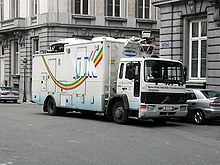Volvo Truck
History
When Volvo manufactured its first automobiles in 1927, the first truck was already on the drawing table and in early 1928, the LV series 1 was presented to the public. Though it, by modern standards, was merely a truck, it was an immediate success and 500 units were sold before the summer. It had a 2.0 L 4-cylinder engine rated at 28 hp (21 kW).
Volvo Trucks worldwide
Volvo cabs are manufactured in the north of Sweden in Umeå and Ghent, Belgium, while the engines are made in the central town of Skövde. Among some smaller facilities Volvo has assembly plants in Sweden (Gothenburg - also the Head Office), Belgium, USA, Brazil, South Africa, Australia, China, India and Russia, making it a truly global producer. Some of the smaller factories are jointly owned. Its main parts distribution centre is located in Gent Belgium. The sales side is split into 3 divisions - European, North American and International, which covers the rest of the world. The offices and dealers are set up worldwide in China, Hong Kong, Taiwan, South Korea
Production facilities
List of Volvo Trucks production facilities:[2]
| Africa
Asia
| Europe
North America
Oceania
South America
|
[edit] North America
In 1980 Volvo bought a portion of White after White's bankruptcy filing. The Canadian assets were purchased by a consortium of two Alberta energy companies, and were renamed Western Star Trucks.[citation needed] The plants in Virginia, Utah and Ohio went to Volvo, which continued to use the White name until the 1990s.[3]
The White Road Commander COE became the Volvo White Integrated Sleeper Conventional when a hood was added.[4]
Throughout the 1980s, Volvo produced White and Autocar, as well as distributing European-made Volvo. The White high cabover engine model was also badged a Western Star and sold through that company's Canadian dealer network.[citation needed]
On August 16, 1986, General Motors announced that heavy duty truck manufacturing in Pontiac, Michigan would be discontinued and that GM's American and Canadian large truck operations would be joined with the Greensboro, North Carolina-based Volvo White Truck Corporation by 1988. The new company, to be based in Greensboro, would be called Volvo G.M. Heavy Truck Corporation[5] and began marketing the Volvo WhiteGMC badge, although all of the legacy GMC product lines were discontinued by 1990.
In 1997 the Volvo WhiteGMC name was discontinued, and all models were badged either Volvo or Autocar. In 2000, the remaining Autocar products were discontinued, and the nameplate was retired (temporarily) after over 100 years.
In a merger announced April 25, 2000, Volvo acquired Renault Véhicules Industriels, including Mack Trucks in North America.[6] The deal would make Volvo Group the second largest truck manufacturer in the world, and the largest in Europe. In order to secure the approval of the authorities to proceed with the merger, Volvo had to agree to divest of its low-cab-over (LCOE) models, known as the Xpeditor range,[7] due to the degree the combination of this product with the Mack MR and LE series dominated the refuse markets in which these vehicles are predominantly used. Volvo would re-enter the LCF market in 2007 with the purchase of UD Nissan Diesel.[citation needed]
In 2001, Volvo divested of the Xpeditor product and the rights to the Autocar trademark. The purchaser was Grand Vehicle Works LLC,[8] a private equity venture based in Hagerstown, Indiana that also produced stripped chassis for vans and recreational vehicles, and walk-in van bodies for parcel delivery service.[citation needed]
In 2009, Volvo began to relocate the operations of its Mack Trucks subsidiary to Greensboro, where the North American operations of Volvo Trucks have been headquartered.[9]
Today, Volvo produces Volvo and Mack class 8 truck models at plants in Dublin, Virginia, and Macungie, Pennsylvania. Affiliate Volvo Powertrain produces engines and transmissions at its Hagerstown, Maryland, facility, for use exclusively in the North American market.
Export markets
Volvo Trucks are exported to and sold by more than 1000 dealers in more than 130 counties, including:[2]
Volvo product range
Current product line-up (as of July 2008)
- Volvo FL
- markets - Europe, Middle East, Australia
- Volvo FE
- markets - Europe, Middle East, Australia
- Volvo FM
- markets - Europe, Africa, Asia, South America, Oceania
- Volvo FH
- markets - Europe, Africa, Asia, South America, Oceania
- Volvo FH16
- markets - Europe, Africa, Asia, South America, Oceania
- Volvo VHD
- markets - North America, Mexico
- Volvo VN
- markets - North America, Mexico
- Volvo VT
- markets - North America
- Volvo VM
- markets - South America
Past products
1920s
| 1930s
| 1940s
|
1950s
| 1960s
| 1970s
|
1980s | 1990s |






Tidak ada komentar:
Posting Komentar